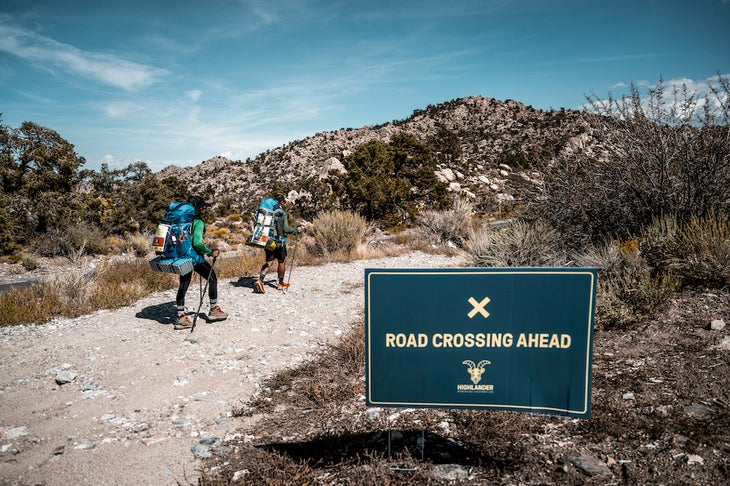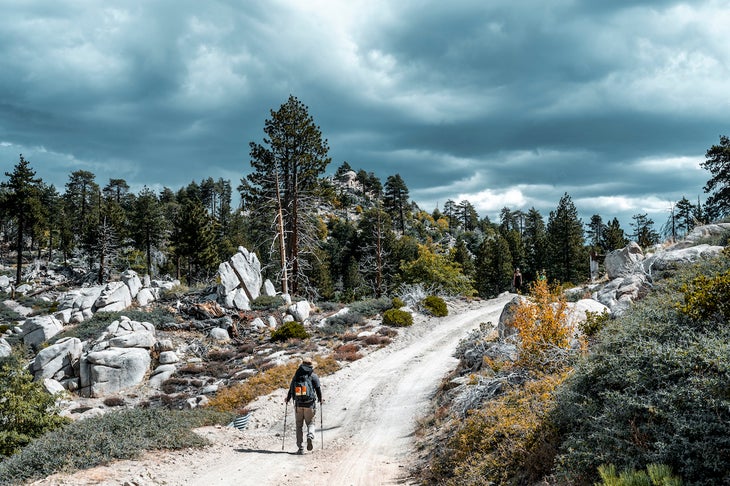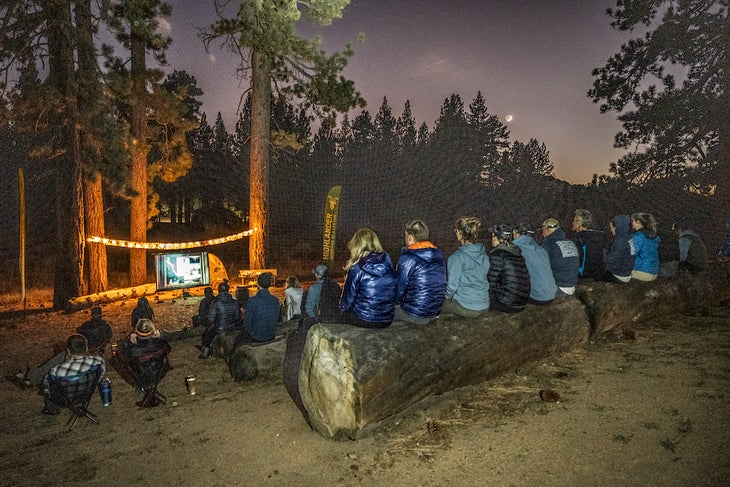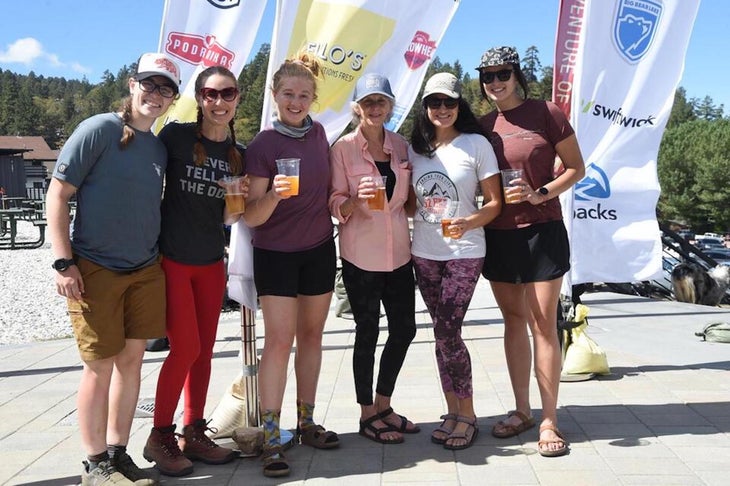Products You May Like
Get full access to Outside Learn, our online education hub featuring in-depth fitness, nutrition, and adventure courses and more than 2,000 instructional videos when you sign up for Outside+
Sign up for Outside+ today.
As I stepped off the trail and onto the hot asphalt, I checked my Gaia app for what felt like the hundredth time that hour. Just a half-mile left, finally. All I had to do to reach Bear Mountain Ski Resort, the final terminus of this backpacking trip, was wind through a couple suburban streets. After 18 miles under my belt that weekend, all above 7,000 feet, my sea-level lungs and undertrained legs were worn out.
I trod forward, trying to ignore the sting of sweat in my eyes as the road reflected the midday heat back at me, when a woman stepped out of her house, cheering while waving a homemade “Welcome, Highlanders!” sign. Soon after, two neighbors watering their lawns paused their conversation to whoop as I passed. This was quite different compared to my regular backpacking trips, where locals usually don’t acknowledge or want much to do with me. They certainly don’t run out of their house with a sign to cheer me on.
The half-mile passed by quicker than expected. Rounding the final street corner and entering the ski resort parking lot, I heard Tom Petty’s “I Won’t Back Down” blasting from the resort patio. As I got closer, a head popped over the patio fence like a meerkat’s, setting off a euphonic swell of cheers, applause, and cowbell clangs. I walked through a finisher’s chute lined with flags and saw dozens of fellow hikers standing out of their seats to cheer, and a FinisherPix photographer took my picture. After posing for the camera, I picked up my commemorative pin, official finisher’s poster, and complimentary burger-and-beer lunch. I don’t normally end a trip like this. I typically throw off my pack, text my family group chat that I’ve made it, and Google “ice cream near me.”

That weekend, I wasn’t a famous influencer, and I didn’t break some coveted FKT. However, I did become one of the first Highlanders in the United States. Highlander is a Croatian backpacking company that organizes hiking adventures throughout Europe, Africa, and the Middle East. And, as of the end of September, Highlander officially added the United States to its roster, with more events planned in 2023. These trips are meant to challenge the participants (called “Highlanders” upon reaching the finisher’s chute) and educate them to become responsible stewards of the lands on which they hike.
I’ve never really considered going on a commercial backpacking trip before Highlander. Why would I pay to do something I could do on my own for free (minus obvious gear and permit costs)? I wondered if it would even be worth it, but the opportunity to explore the backcountry and find community through hiking piqued my interest. There were three routes to choose from at Big Bear: a 60-, 30-, or 15-mile trek, which actually ended up being 65, 34, and 18 miles on the trail and took 5 days, 3 days, and 2 days to finish, respectively. Each night, there was a designated campsite with warm meals (and cold drinks!) provided and optional activities planned, such as talks from outdoor industry professionals. These distance options seemed to accommodate any type of hiker: In attendance there was anyone from an experienced thru-hiker to a first-time backpacker. There was even an 8-month-old who joined his mom and grandma on the trail.
Another thing that interested me about Highlander was that the experience seemed to be more about the journey than the destination. In fact, the company even says on its website: “Highlander is not a race, it is an adventure.” There were no prizes for arriving at the checkpoints first, and event organizers encouraged the 300 participants to take pictures or sit in awe at vistas.
Better yet, I liked that this wasn’t necessarily a guided event either. I’ve taken guided trips in national parks and locally through the Sierra Club, and it seems like the group always goes either way too fast or way too slow. Highlanders could hike their own hike. They just have to follow the clearly marked trail and arrive at the designated campsite before 10 p.m. each night. They don’t even have to leave the campsite by a certain time each morning! I was relieved I wouldn’t have to panic-wedge my bunched tent into my pack while a group of early bird hikers passive aggressively stood 5 feet away, checking their watches and commenting about the rising sun.

So, I signed up. Here’s how it went:
The night before the trip, I had some pre-camp jitters: What if I don’t make any friends? What if everyone comes with their group, and I’m the only one going alone? My worries faded as soon as I sat down on the bus that took us to the start of our point-to-point trek. Karla Amador, the co-founder of the 52 Hike Challenge, sat down next to me, and we hit it off. We eventually hiked the entire 18 miles together, and throughout the trek, we made more friends. There were hikers from over 20 states on this trip, so we hiked and chatted with people from Montana, Florida, Vermont, Texas, California, and more.
When I’ve backpacked on my own, I’ve made friends on the trail or at camp, sure, but those friendships don’t normally last longer than the amount of time we’re on the trail. At Highlander, though, there was a sense of bonding and collective accomplishment that made everyone eager to buoy each other. At the end of the weekend, some of us exchanged Instagram handles, email addresses, and phone numbers, and we penciled in plans to hike together this fall.
In a lecture about the history of the ultralight movement, Matt Favero, the marketing director of ZPacks, told the crowd of Highlanders at our campsite: “I’ve hiked thousands of miles, and there’s nothing like the vibe that’s going on right here.”
It didn’t matter which type of Highlander you were; everybody got the star treatment. We were glampacking.
At night, musicians entertained the hikers, outdoor industry professionals gave speeches, instructors led yoga classes, and participants watched a screening of “Highline” under tealights. As a Backpacker editor, I’ve read, watched, and written quite a bit about the basics of backpacking, but I still learned something. There was also a physical therapist performing on-site tune-ups and evaluations for sore hikers.

Checkpoints along the trail offered water refills, which was helpful for long stretches between natural sources. I was relieved that I didn’t have to weigh my pack down with all my water for the whole weekend, and could carry only a couple liters at a time. Hikers also had the option to purchase a photo package and download the photos that FinisherPix took along the trail. I’m horrible at remembering to take pictures of myself, so I’m glad that there’s some evidence that I was on the trail, as opposed to the haphazard sunscreen-smudged pictures of verdant vistas that I usually take.
“What you guys are experiencing this weekend isn’t normal,” public lands advocate Benny Braden told us during his lecture on leaving no trace before the trek. “It’s special. It’s really, really special.”
This was all great, but my favorite part was the food. Highlander provided loads of snacks and drinks at every stage of the trip, including freshly cooked Mexican food for dinner. After hours of hiking in the heat, having fresh tacos, rice and beans, guacamole, and churros was amazing. And the fact that I didn’t have to cook any of it tasted best of all. Who would scoff at fresh food at night? A hiker masochist, I guess, but I’d rather have hot churros than cold-soaked noodles. They passed out so many snacks that I may have actually ended with more food than i began with The cherry on top was having an ice-cold GT’s Trilogy kombucha and HOP WTR (flavored sparkling water infused with hops) both at the campsite and finish line.

The resources and constant support that Highlander provides make backpacking accessible to those with little planning or hiking experience. It’s comforting to have the security and accountability of Highlander and fellow hikers if you don’t know how to start backpacking, if you get lost on trail, or if you forget essential gear. For example, one new-to-backpacking participant didn’t bring a tent but was pretty sure she could rough it through the near-freezing temperatures at night. Instead of sitting by as she turned into a popsicle overnight, one of the event directors scrounged up a Zpack tent for her to borrow.
But plenty of seasoned hikers, myself included, got a lot out of the experience, too. At the finisher’s party held at the ski resort, I spoke with several backcountry regulars who participated in Highlander. We talked about trip highlights, compared hiking resumes, and made plans to reunite at an upcoming Highlander U.S. event next year. It’s a treat to get the opportunity to meet hikers from all around the country.
At the end of the trip, I shared a beer with Aljosa Vojnovic, the marketing director for Highlander. He told me that he loved seeing the hikers take on the challenging course and become stronger because of it. Some 60-milers, Aljosa said, cried when they passed through the finisher’s chute because they were so proud of their accomplishments.
Commercial hiking tours are more popular in Europe than they are in America. Guiding companies offer regular backpacking tours through the Tour du Mont Blanc, the Amalfi Coast, the Camino de Santiago, the Scottish Highlands, and more. While American guides offer group trips stateside, the culture of backpacking here is one of rugged independence. And while there’s certainly merit to venturing out on one’s own, hiking in America can feel exclusive and difficult to break into.
Sure, you can go on backpacking outings through the Sierra Club, REI, or many local outdoor retailers, but they don’t compare to something as large-scale and luxurious as Highlander. Beyond the annual Fjällräven Swedish Classic, there aren’t too many all-inclusive backpacking trips offered in the U.S. Trips like this lower the barrier to entry to backpacking because newbies can ask experts questions about pack fitting, the benefits of poles, Leave No Trace principles, what gear is worth money, and more.
But, after becoming a Highlander, I realize that there’s a separate value in the curated experience that I don’t get elsewhere. On my own, I don’t have a churro nightcap before bed. I don’t get professional photos taken of me. I absolutely don’t get such an instant and diverse collection of hiking friends on the trail. While I won’t give up my solo adventures any time soon, Highlander was a welcome change. Solitude and rugged self-reliance will be there whenever I want, but for now, I’m looking forward to the amenities and community of next year’s Highlander Big Bear trip.
